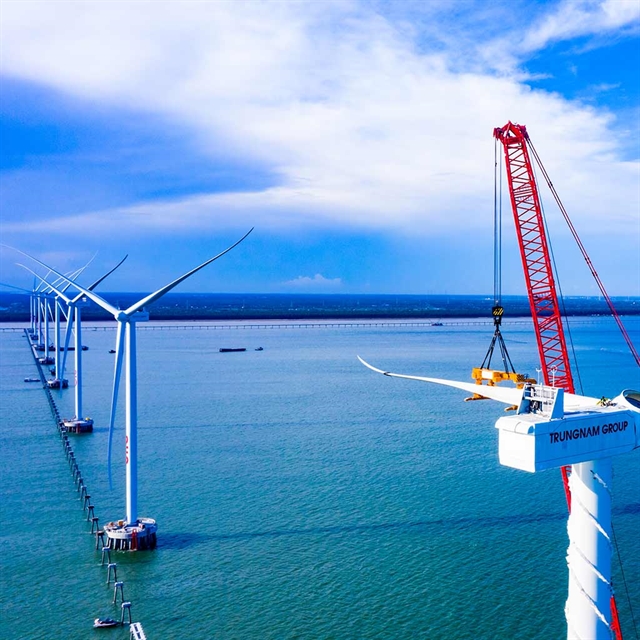 Economy
Economy

Việt Nam needs substantial investments to meet the country’s goal of net-zero emissions by 2050, but gathering sufficient financial resources for renewable transition is not an easy task.

|
| Wind turbines under construction in the three CBI-certified projects in Quảng Trị Province. The projects were expected to generate 422 GWh of electricity per year and avoid over 160,000 tonnes of CO2 emissions annually. Photo ADB.org |
Việt Dũng
HÀ NỘI — Việt Nam needs substantial investments to meet the country’s goal of net-zero emissions by 2050, but gathering sufficient financial resources for renewable transition is not an easy task.
The recent Power Development Plan 8 (PDP8) estimates an annual financial need of around US$11 billion for power projects between 2021 and 2030, much of which are allocated for renewables.
Meanwhile, most renewable energy projects in the country have been developed by domestic companies. Specifically, Mekong Infrastructure Tracker (MIT) shows that 58 per cent of the projects were developed solely by Vietnamese companies, 27 per cent jointly by Vietnamese companies and their international partners, and just 12 per cent otherwise.
That means the initial costs of renewable transition have fallen largely to domestic companies, which are believed to have inadequate financial capacity to meet future investment needs. Net-zero goals, thus, could become unachievable unless the country unlocks more international funding and bolsters green finance.
Regarding international funding, MIT’s data suggest that most foreign companies involved in renewable energy projects in Việt Nam come from other Asian countries, including Thailand, Japan and the Philippines.
Notably, Thai company B.Grimm Power issued $242.7 million of debentures in 2021 to fund two solar farm projects in Phú Yên and Tây Ninh provinces. The two projects have a combined capacity of 677MW and were allocated 87 per cent of the proceeds.
The Japan International Cooperation Agency (JICA) signed a facility agreement the same year to provide $25 million for an onshore wind farm in Quảng Trị Province. The project was the first JICA-financed wind power project in Việt Nam with a capacity 144MW.
The Philippines' Ayala Corp. followed suit in February by securing 49 per cent ownership of Solar NT, a unit of Thai Super Energy Corp. in Việt Nam. The acquision allows Ayala to take hold of nine solar power plants in the country with a total capacity of 837MW.
It is also worth noting that China is largely absent as a project initiator or financier in Việt Nam despite Chinese companies’ growing presence in neighbouring Cambodia and Laos. In contrast, the US has begun to become more involved in Vietnamese clean energy projects thanks to its commitments to promote renewable transition.
One of such commitments materialised in June as the US Agency for International Development kicked off the Low Emission Energy Programme II worth $36 billion to promote the use of clean energy in Việt Nam.
The above-mentioned figures indicate ample room for capital development. To unlock more international funding, a report jointly prepared by Stimson Center and the International Union for Conservation of Nature suggests Việt Nam address four regulatory obstacles.
First, the Vietnam Electricity (EVN)’s standard Power Purchase Agreements (PPA) for solar projects allocates too much risk to project developers. The corporation can curtail purchases at any moment for an indefinite period of time. The absence of a purchase guarantee is at odds with global practices and discourages many foreign investors.
Second, Việt Nam has offered a competitive Feed-in Tariff (FIT) for solar energy projects since 2017 but the FIT was adjusted numerous times, giving developers too little time to qualify for the new FIT. Additionally, there were sometimes long gaps without an official FIT, creating uncertainty over which FIT would apply when a project comes into operation.
Third, registering a new project involves cumbersome permit procedures, from initial project approval to integration to the provincial plans to land permits. Such a lengthy administrative process can be daunting task for foreign investors without local connections.
Fourth, favourable policies on rooftop solar have been introduced by the Vietnamese Government since 2020. However, rooftop solar alone is not enough to achieve long-term carbon reduction targets, and many companies want to buy clean energy directly from outside producers. The Ministry of Industry and Trade announced plans for a direct PPA scheme in 2019 but the plan moved at a slow pace.
The report recommends the Government put PPA on top of its agenda and issue a revised PPA that is attractive to foreign investors. That move would be of great benefit since direct PPA encourages international companies to invest in their own renewable energy generation and reduce demand on the national grid.
The Government is also called on to refine legal frameworks to ensure that permitting and pricing policies are transparent and clear, and go with longer time horizons to avoid uncertainty.
Economist Võ Trí Thành believes that green finance is a huge source of finance that can help companies speed up on the journey to renewable energy. In many countries, green bonds, green capital and green credit have grown ten times more quickly than traditional credit in the past five years.
However, financial markets in Việt Nam are still at a nascent stage green-wise, so various domestic green instruments, such as green bonds, are not so easily accessible for companies. Consequently, a large portion of domestic resources could not flow into renewables, slowing down the progress towards green energy.
The economist urges the Government to improve the transparency of the bond market and lay the foundations for its steady growth. Once the market develops fully, domestic green bonds will gain ground.
"One of the foundations is the development of long-term financial institutions, including retirement funds and insurance funds. Another foundation involves government bonds, which is a major determinant of the market yield curve," he clarified.
He also underscores credit-rating agencies as another foundation for a robust bond market because these agencies help improve investors' exposure to risk and reduce issuers' costs of capital.
Regarding international funding, he recommends Vietnamese companies stay well-informed about new sources of green finance and improve themselves to become eligible for these sources.
"FiinGroup has been approved by the Climate Bonds Initiative (CBI) to become its first authorised green bond verifier in Việt Nam. Vietnamese fund-seekers should bear in mind that a CBI-certified company will have a great opportunity to access bond capital mobilised from investment funds around the world," he added.
The economist also notes that the Asian Development Bank (ADB) granted a green loan of $116 million to three Vietnamese companies to finance three wind farms in Quảng Trị Province in 2021. The three farms were the first ADB-financed wind projects in the country and certified by the CBI.
Some experts propose eco-tax to boost fiscal revenues, which can be used to finance renewable energy projects. However, Thành believe the tax itself does not matter, but how much to levy, when to levy and whom to levy.
He also believes that the Government should give careful thought to the tax since an improperly-collected tax could turn out counter-productive given the limited financial capacity of many Vietnamese companies.
"Eco-tax is a market-based policy instrument that would incentivise enterprises to incorporate green targets into their business. For the tax to produce good effects on renewable transition, it's all about how much to levy, when to levy and whom to levy," he said. — VNS




